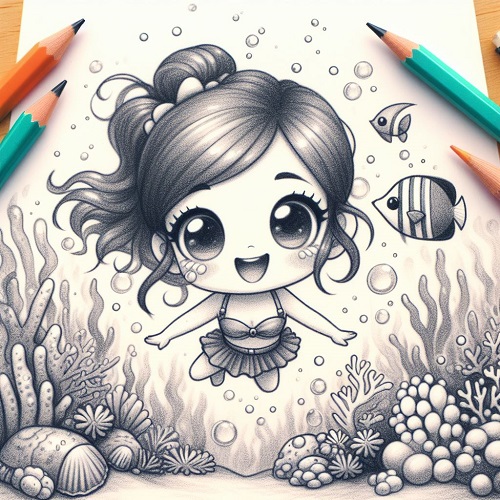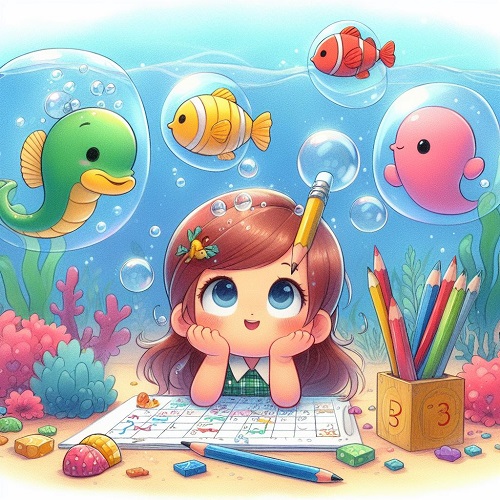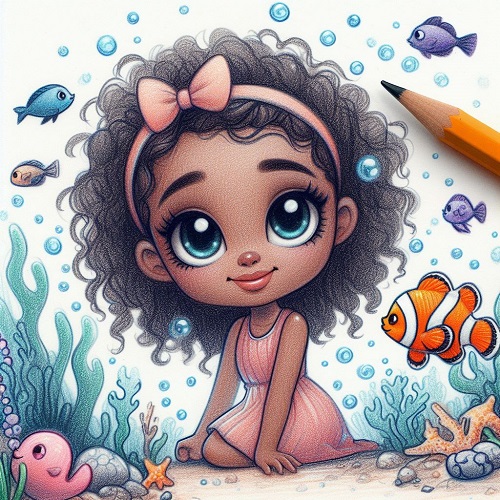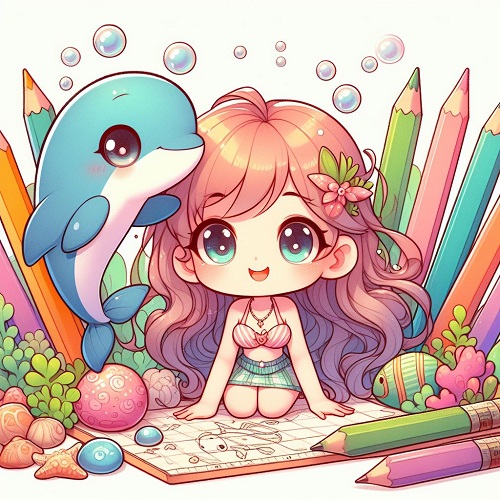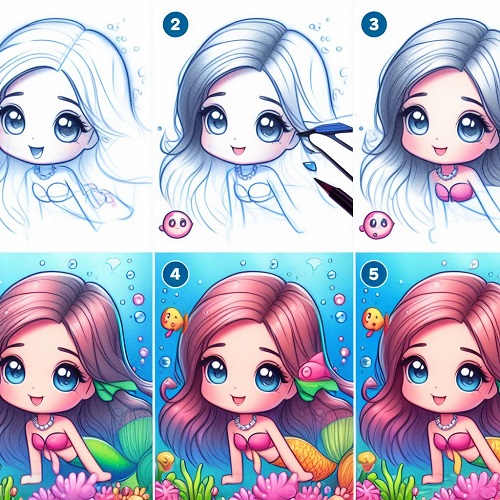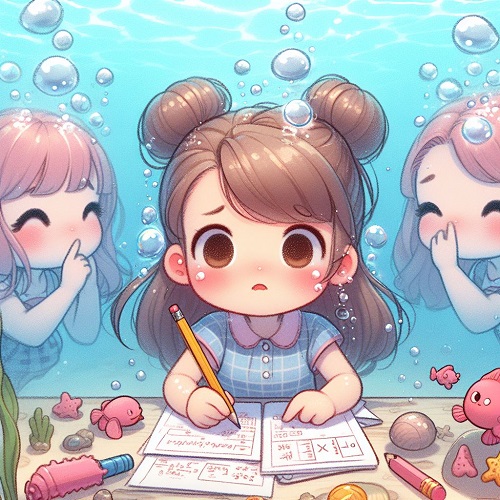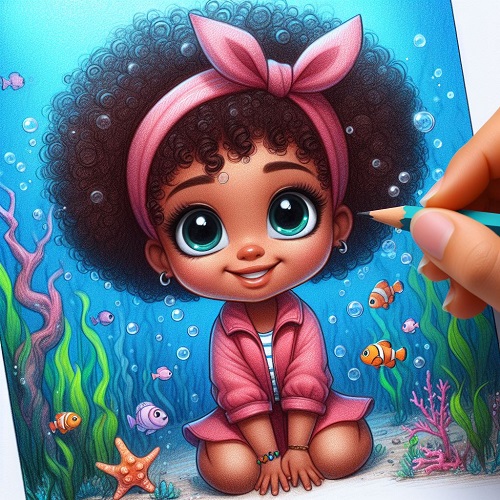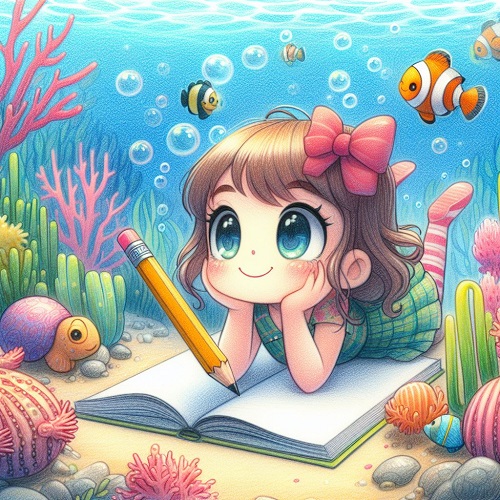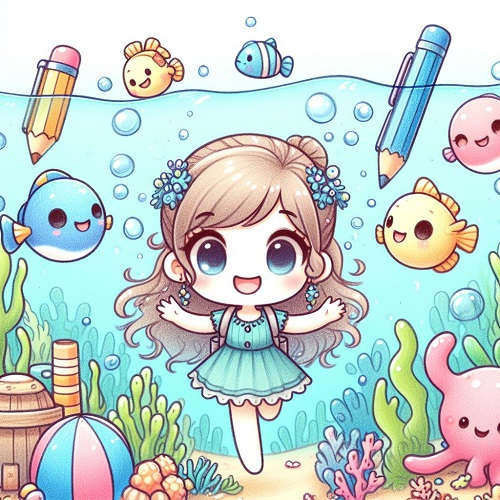Dive into Creativity: The Magic of Underwater Pencil Drawing
Embark on a journey into the enchanting world of underwater pencil drawing, where the wonders of the ocean come to life through the strokes of your pencil. The allure of underwater scenes captivates artists worldwide, and in this article, we’ll explore how pencil drawing can transform the depths of the sea into breathtaking works of art. From the play of light on the ocean floor to the intricate details of marine life, we’ll dive deep into the techniques and inspiration that make underwater pencil drawing a truly magical experience.
Understanding Underwater Pencil Drawing:
Delve into the artistry of underwater pencil drawing by mastering fundamental techniques. Shading and texture are paramount in recreating the fluidity of water on paper. Discover how the choice of pencils, from the subtle H grades to the bold B grades, can influence your depiction of underwater landscapes. Learn the art of cross-hatching and blending to bring depth and realism to your drawings. Additionally, explore the significance of selecting the right paper, considering texture and durability as crucial factors in preserving the intricate details of your underwater masterpiece.
Inspiration from the Deep:
Take inspiration from accomplished artists who have captured the essence of underwater beauty with their pencil strokes. Analyze the works of masters such as Robert K. Rae and Ester Roi, gaining insights into their techniques and use of light and shadow. Understand how underwater environments, with their vibrant colors and unique perspectives, serve as a constant source of inspiration for artists seeking to convey the magic of the deep.
Getting Started: Materials and Tools:
Uncover the magic behind the artist’s primary tools: pencils and paper. Explore the wide range of pencils available, from 9H for fine lines to 9B for rich, dark tones. Delve into specialty pencils designed for underwater scenes, like water-soluble graphite, which adds an extra layer of fluidity to your drawings. Understand the importance of quality paper in preserving your artwork, considering factors like weight, texture, and archival properties.
Step-by-Step Guide to Underwater Pencil Drawing:
Embark on a creative journey with our step-by-step guide to underwater pencil drawing. Begin by sketching the basic composition, outlining the key elements of your underwater scene. Learn to build layers to create depth, using lighter strokes for distant objects and bolder strokes for foreground elements. Add intricate details, from the delicate scales of fish to the swaying tendrils of seaweed. Dive into the techniques for capturing the play of light and shadows, replicating the dynamic interplay that defines the underwater world.
Troubleshooting Common Challenges:
Navigate common challenges encountered when portraying underwater elements. Tackle the complexities of water movement by understanding the principles of fluid dynamics and employing techniques to convey its ebb and flow. Address difficulties in rendering aquatic flora and fauna, from the translucency of jellyfish to the intricacies of coral formations. Elevate your skills with expert tips and solutions, ensuring your underwater drawings transcend challenges and emerge as true works of art.
Showcasing Your Underwater Masterpiece:
Explore options for showcasing and preserving your underwater masterpiece. Learn about digitalization techniques that allow you to share your art with a global audience. Discover potential exhibition opportunities, from local art shows to online galleries, and understand the steps involved in building an online portfolio. Maximize visibility for your work and connect with fellow artists, creating a community that appreciates the beauty and intricacy of underwater pencil drawing.
Drawing Inspiration from Nature:
Delve into the therapeutic benefits of underwater pencil drawing and its unique ability to foster a connection with nature. Explore the calming effect of recreating underwater scenes, providing a meditative escape from the stresses of daily life. Connect with marine life and ecosystems through your art, gaining a profound appreciation for the delicate balance that exists beneath the waves.
Community and Resources:
Join vibrant online communities dedicated to underwater artists, where you can share your work, exchange ideas, and learn from others. Explore recommended books and courses that delve into the nuances of underwater drawing, providing valuable insights and techniques to enhance your skills. Connect with like-minded enthusiasts who share your passion for the mesmerizing world of underwater pencil drawing.
Conclusion:
As we conclude our exploration of underwater pencil drawing, take a moment to appreciate the enchanting journey you’ve embarked upon. Whether you’re a novice seeking inspiration or an experienced artist looking to refine your skills, let the magic of underwater scenes inspire your creativity. Dive into your own creative seascape, armed with the knowledge and techniques shared in this comprehensive guide, and discover the boundless possibilities that await beneath the surface.
FAQs for Each Topic:
Understanding Underwater Pencil Drawing:
Q1: What are the key techniques for mastering underwater pencil drawing?
A1: Shading and texture play a crucial role in recreating the fluidity of water. Explore cross-hatching and blending techniques to bring depth and realism to your drawings.
Q2: How do I choose the right pencils for underwater scenes?
A2: Consider a range of pencils, from subtle H grades for fine lines to bold B grades for rich tones. Explore specialty pencils like water-soluble graphite for an added layer of fluidity.
Q3: What factors should I consider when selecting paper for underwater pencil drawing?
A3: Weight, texture, and archival properties are essential. Choose quality paper to preserve the intricate details of your underwater masterpiece.
Inspiration from the Deep:
Q1: Can you recommend famous artists known for their underwater pencil drawings?
A1: Renowned artists like Robert K. Rae and Ester Roi have captured the essence of underwater beauty. Analyze their works to gain insights into techniques and use of light and shadow.
Q2: How can underwater environments inspire my pencil drawings?
A2: The vibrant colors and unique perspectives of underwater scenes serve as a constant source of inspiration, pushing artists to convey the magic of the deep.
Q3: Are there specific elements in underwater scenes that artists commonly draw inspiration from?
A3: Artists often draw inspiration from the dynamic interplay of light, the diverse marine life, and the intricate details of underwater flora and fauna.
Getting Started: Materials and Tools:
Q1: What is the significance of using specialty pencils for underwater scenes?
A1: Specialty pencils, such as water-soluble graphite, add an extra layer of fluidity to your drawings, allowing you to capture the dynamic nature of water.
Q2: How can the weight of paper impact my underwater pencil drawings?
A2: The weight of the paper affects its durability and the preservation of details. Choose a suitable weight to ensure your artwork remains intact and vibrant over time.
Q3: Are there specific pencils recommended for beginners in underwater pencil drawing?
A3: Beginners can start with a variety of pencils, exploring different grades to understand their effects on shading and tone.
Step-by-Step Guide to Underwater Pencil Drawing:
Q1: How do I begin sketching the composition for an underwater scene?
A1: Start by outlining the key elements of your underwater scene, focusing on the basic composition before delving into details.
Q2: What techniques can I use to add depth to my underwater drawings?
A2: Build layers in your drawings by using lighter strokes for distant objects and bolder strokes for foreground elements. This creates a sense of depth and dimension, replicating the three-dimensional aspect of underwater landscapes.
Q3: What are some tips for capturing the play of light and shadows in underwater scenes?
A3: To capture the dynamic interplay of light and shadows, pay attention to the direction of light sources. Experiment with shading techniques to replicate the effects of sunlight filtering through water, creating a realistic and immersive atmosphere.
Troubleshooting Common Challenges:
Q1: How can I overcome challenges in portraying water movement in my drawings?
A1: Understand the principles of fluid dynamics and experiment with techniques to convey the ebb and flow of water. Consider incorporating subtle lines and strokes to represent the movement and turbulence of underwater currents.
Q2: What challenges might arise when drawing aquatic flora and fauna?
A2: Challenges may include rendering translucency, capturing intricate details, and maintaining proportions. Practice observational drawing and explore various shading techniques to overcome these challenges and bring underwater life to vivid representation.
Q3: How can I ensure my underwater drawings are realistic and visually appealing?
A3: Pay attention to the details and textures of underwater elements. Practice observational drawing, study reference images, and continuously refine your techniques. Experiment with different pencils and shading methods to achieve a realistic and visually appealing result.
Showcasing Your Underwater Masterpiece:
Q1: What are the advantages of digitalizing my underwater pencil drawings?
A1: Digitalizing your artwork allows for easy sharing across online platforms, reaching a broader audience. It also provides opportunities for customization, enabling you to experiment with colors and effects.
Q2: How can I find exhibition opportunities for my underwater drawings?
A2: Explore local art shows, galleries, and online platforms that showcase pencil drawings. Submit your work to relevant exhibitions and build connections within the art community to discover potential showcasing opportunities.
Q3: What steps should I take to build an online portfolio for my underwater drawings?
A3: Choose a user-friendly platform for creating an online portfolio. Showcase a diverse range of your underwater drawings, provide background information, and include a contact section for potential collaborations or inquiries.
Drawing Inspiration from Nature:
Q1: How does underwater pencil drawing contribute to therapeutic benefits?
A1: Engaging in underwater pencil drawing provides a meditative and calming experience. The focus required to replicate intricate details and the connection with nature can serve as a therapeutic outlet, reducing stress and promoting relaxation.
Q2: Can underwater pencil drawing help me connect with marine life and ecosystems?
A2: Yes, through the process of observing and recreating underwater scenes, artists can develop a deeper appreciation for marine life and ecosystems. This connection often translates into a more profound understanding of the delicate balance within aquatic environments.
Q3: Are there specific techniques for capturing the calming effects of underwater scenes in drawings?
A3: Utilize soft and flowing lines, incorporate gentle shading, and focus on creating a serene atmosphere in your drawings. Experimenting with colors associated with tranquility, such as blues and greens, can further enhance the calming effects of your artwork.
Community and Resources:
Q1: How can I join online communities for underwater artists?
A1: Seek out forums, social media groups, and platforms dedicated to underwater art. Engage with fellow artists, share your work, and participate in discussions to connect with a supportive community.
Q2: Are there recommended books or courses for improving underwater pencil drawing skills?
A2: Explore resources such as “Underwater Drawing Mastery” by [Author] or online courses offered by art institutions. These resources provide valuable insights, techniques, and exercises to enhance your underwater drawing skills.
Q3: What are the benefits of connecting with like-minded enthusiasts in the underwater art community?
A3: Connecting with fellow artists provides opportunities for collaboration, learning, and inspiration. Share experiences, seek feedback, and participate in collaborative projects to expand your network within the underwater art community.
Conclusion:
As we conclude our immersive exploration of underwater pencil drawing, you now possess a comprehensive guide to unleash your creativity beneath the waves. Whether you’re embarking on this artistic journey as a beginner or refining your skills as an experienced artist, may the magic of underwater scenes inspire your imagination. Dive into your own creative seascape, armed with the knowledge, techniques, and inspiration shared in this guide, and let your artistic endeavors flourish beneath the surface of creativity.
- Mastering the Art: A Comprehensive Guide to Pokemon Pencil Drawing
- Mastering the Art of Pencil Drawing on Canvas: Your Comprehensive Guide
- Unveiling Artistry: A Comprehensive Guide to Horse Pencil Drawings
- Mastering the Art of Pencil Drawing Cartoon Characters: A Comprehensive Guide
- Unleash Your Creativity: A Comprehensive Step-by-Step Guide to Colored Pencil Drawing
- Unleashing the Depths of Creativity: A Comprehensive Guide to Octopus Pencil Drawing
- Unlocking the Artistry: A Deep Dive into Black Pencil Drawing
- Mastering the Art of Tree Pencil Drawing: A Step-by-Step Guide for Aspiring Artists
- Dive into Creativity: The Magic of Underwater Pencil Drawing
- Unleashing Creativity: Mastering the Art of 2B Pencil Drawing

